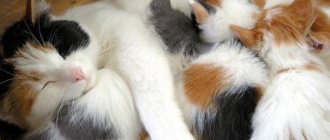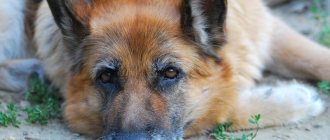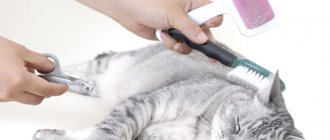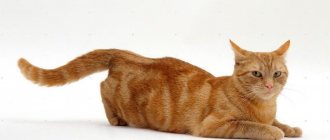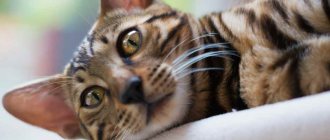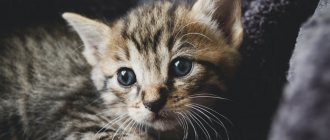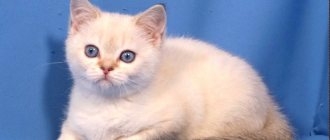The cause of frequent illnesses among Scots
Scottish Straights have good health and good immunity, but Folds obtained as a result of a gene mutation are much more prone to disease. Most often, they have deviations in the development of the musculoskeletal and vestibular systems.
The mutation gene that leads to the appearance of lop ears in cats is dominant. It always appears in offspring obtained from the mating of two individuals of this breed.
At the same time, the influence of the mutation gene often leads to the following disorders:
- pathologies of skeletal bones, cartilage and ligaments;
- abnormal structure of the ear canals;
- improper formation of the eyelids.
To prevent genetic diseases that cannot be treated, breeding of fold-eared cats is carried out only with straight-eared individuals.
Such crossing cannot completely remove the influence of a negative gene, but it helps reduce the likelihood of the offspring developing genetic diseases, and following the recommendations for the care and education of Scots will make their lives longer and more fulfilling.
Breed pathologies
Even those folds that were born from crossings with straights have a tendency to diseases associated with improper development of bone and cartilage tissue. Therefore, pathologies such as osteochondrodysplasia, osteochondrodystrophy, arthrosis, arthritis, etc. can develop in their body.
Other problems that Scottish Fold owners most often encounter include:
- cardiomyopathy;
- diseases of the gastrointestinal and genitourinary systems;
- diseases of the ears and eyes;
- viral infections.
Scottish cats have congenital eye pathologies associated with the structure of the skull. The skin covers it in such a way that 1 or both eyelids turn in (turn inside out).
Eversion or inversion of the eyelids leads to the fact that the edge of the eyelashes constantly touches the eyeball, which irritates it and can damage the pupil to the point of blindness. This problem can only be corrected through surgery.
If an animal's eyelids do not cover its eyes well, it will suffer from increased photosensitivity. Scottish Folds with this eyelid structure have watery eyes from bright light; pets should not be kept in rooms with fluorescent lighting.
Common diseases
A predisposition to a disease may remain only a hereditary tendency, but sometimes it leads to the development of dangerous and even fatal pathologies. Genetic diseases of Scottish cats include osteochondrodystrophy and hemophilia B type.
The owner of a lop-eared pet may not be aware of the latter until injuries occur or a planned operation is performed.
Hemophilia is characterized by impaired blood clotting due to a lack of fibrin and increased bleeding in cases of damage to the integrity of the skin, oral and nasal mucosa.
The damaged area is not covered with a protective crust, which can lead to the death of the animal from blood loss.
Osteochondrodystrophy in cats
Cats with OCD do not jump, walk stiffly on stiff legs, or limp. Their external structure is characterized by a large head, a curved jaw, a thick tail that cannot move, and short limbs with swollen or deformed joints.
Disorders of skeletal motor function occur due to a defect in the development of cartilage tissue, leading to progressive osteoarthritis.
An incorrect ossification process in kittens leads to dwarfism and deformations of the bones of the peripheral and axial skeleton; the animal hardly grows, and over time acquires a squat appearance. Pet owners may not immediately notice the manifestations of the disease, since Scottish Fold cats have a small body weight and can redistribute the load from diseased paws to healthy ones.
Often, lameness can appear in kittens that are only a few weeks old, and as they grow and the load on the skeleton increases, the animal’s condition will only worsen. OCD is detected by radiography.
This genetic pathology cannot be treated until complete recovery and ends in death. To relieve pain and alleviate the condition of the animal, veterinarians prescribe non-steroidal anti-inflammatory drugs, GAGs and other chondroprotectors.
Conjunctivitis and glaucoma
Acquired eye diseases of Scottish Folds include various infections (conjunctivitis, keratitis, blepharitis), glaucoma and cataracts. Conjunctivitis can occur even with the slightest contamination or damage to the mucous membrane of the eye due to the fact that it is poorly protected by the eyelids. The eyes become inflamed and begin to water.
Conjunctivitis often plagues kittens - their immunity has not yet developed, and the body remains defenseless against infection. Regularly washing the eyes with chamomile decoction or tea leaves can alleviate the animal's condition. In advanced cases, the veterinarian prescribes special drops and ointments.
Symptoms of glaucoma appear gradually and occur in older cats. Intraocular pressure increases, swelling of the eyeball appears, and it increases in size.
Over time, clouding of the lens develops, which can result in complete blindness of the animal. In order not to miss the manifestations of this disease in your pet and to start treatment on time, it is recommended to check your cat’s vision once every 6 months.
ENT diseases
The ears of fold-eared cats are irregular in shape or have an underdeveloped inner part. In this case, the ear is not adapted to perceive sound and the animal will have congenital deafness that cannot be corrected.
Due to the curvature of the ear cartilage, dirt and wax secretions accumulate in the shell. If they are not removed regularly, the cat may develop otitis media and other ear infections, and in advanced cases, tumors.
Symptoms indicating the occurrence of the disease: the animals' ears are very itchy, the skin on them is red and inflamed, and mucus with an unpleasant odor or pus is secreted from the inside. The prevention of ear diseases includes hygiene procedures, but if the pet does get sick, then the medications, ointments and drops necessary for treatment will be prescribed by a doctor at the veterinary clinic.
Fold-eared cats are breeds that have a shortened head shape, and therefore are prone to respiratory system disorders - the so-called. brachycephalic syndrome. It manifests itself as hoarse sounds when breathing and snoring during sleep.
Problems with the gastrointestinal tract
The following pathologies are observed in the digestive organs of Scottish Folds:
- inflammation of the stomach;
- liver diseases;
- helminth infection;
- food allergy.
With gastrointestinal diseases, cats become lethargic and refuse to eat, and suffer from increased thirst. The most common symptoms: nausea, vomiting, stool disorder in the form of diarrhea, constipation, or the appearance of undigested pieces of food in excrement.
Problems with the digestive system can also be indicated by skin manifestations - rashes and eczema. Only a specialist can establish the correct diagnosis and prescribe treatment.
Viral diseases
Rhinotracheitis is a respiratory disease caused by the feline herpes virus. Accompanied by fever, sneezing, coughing, discharge from the nose and eyes. With proper treatment it goes away in 7-10 days.
Calicivirus affects the respiratory system and the mucous membranes of the mouth and nose - ulcerations appear on them.
Parvovirus causes panleukopenia in cats, a dangerous disease affecting the gastrointestinal tract, heart and bone marrow. Accompanied by fever, vomiting and diarrhea, which leads to dehydration and death of the animal. Only complex comprehensive treatment prescribed by a veterinarian will help save him.
Pericarditis
Pericarditis is the most common disease of Scottish Fold cats affecting the cardiovascular system. Causes of appearance: infectious and colds, infection with parasites. With pericarditis, the cat's heart sac becomes inflamed. The disease can have an acute and chronic form. The animal's activity decreases, shortness of breath appears, body temperature rises, it feels pain, and symptoms of intoxication appear. Only a veterinarian can make an accurate diagnosis after examining the pet’s health. When treating, they first try to cope with the cause of pericarditis. In addition, therapy is carried out aimed at eliminating symptoms. The cat is given antibiotics, anti-inflammatory and diuretic drugs.
Obviously, in such a unique breed as the Scottish Fold cat, diseases are often associated with the peculiarities of their structure, as well as with a mutation of the gene responsible for the shape of the ears. Hereditary diseases that Scottishfolds are prone to can be avoided if you breed them wisely. You cannot mix animals of the same breed, otherwise a certain percentage of sick kittens will appear in their litter. It is necessary to carefully monitor the coat and eyes of Scottish pets. When the first symptoms of the disease occur, the animal must be immediately shown to a doctor.
Vaccination and other methods of disease prevention
Viruses enter the body through air, food and water, and can be carried into the home from a person’s clothing. Therefore, even pets that are never outdoors at all need to be provided with good care, proper nutrition, the necessary vitamins and vaccinations on time.
Prevention of hereditary diseases in Scottish Folds is their mating with representatives of exclusively straight-eared breeds, and other pathologies - timely vaccination. The choice of drugs for vaccinations is made by the doctor, taking into account the conditions under which the animal is kept.
The first vaccination is given with a rabies vaccine or a complex preparation. By this time, the kittens should be 6-10 weeks old; if the offspring were obtained from a vaccinated cat in compliance with the crossing conditions, then vaccination can begin at 12 weeks. At six months they are re-vaccinated, and when the pet reaches 1 year old, he is vaccinated annually.
In the 1st year of life, animals are given medications for panleukopenia, microsporia, rhinotracheitis, calicivirus and calicivirosis. Vaccines are administered to pets after examination and are recorded on the vaccination record to avoid repetition.
The animal must be active, have a normal body temperature and have no symptoms of any disease. To avoid poisoning your cat with the products of mass death of parasites caused by the vaccine, you should first carry out deworming.
Description of the breed
Scottish Straights crossed with the British and inherited some of the similar traits - appearance, character. But they have pronounced differences. For example, a round muzzle, size, grace, flexibility.
Origin of the breed
The homeland of this breed is Scotland. The first kittens appeared in the early 60s. Among the Folds (Scottish Fold), babies with erect ears were periodically born. At first they were culled, but then a separate breed was developed (Scottish Straight). The first cat of this species was Susie from Tayside .
To produce straight-eared kittens, they were first crossed with Britons. They tried to breed a pure breed by mating only straights, but the experiment failed. The kittens were born weak, with congenital anomalies and diseases. Then they began to cross lop-eared with straight-eared. Healthy, strong kittens began to be born.
Lifespan
Scottish Straight cats live up to 10-15 years. It depends on the conditions of detention. With proper care, nutrition, and treatment, they can live longer. There are congenital pathologies that cannot be treated. Then life expectancy is less than 10 years.
Exterior
Scottish Straights are medium in size. Females weigh 3-5 kg, males – up to 5-6 kg. Larger pets are rare. Exterior parameters:
- the body is proportional, stocky;
- the head is round;
- ears are medium in size, with sharp tips, elastic cartilages;
- the eyes are round, large, color - from amber to brown, sometimes blue;
- high forehead;
- the neck is thick;
- a wide short nose with a noticeable base, due to which the profile is clearly defined;
- paws are short, powerful, round pads;
- the tail is long, very mobile, slightly tapering towards the tip.
The coat is soft, plush, thick. According to it, cats are divided into short- and long-haired.
Popular colors
Scottish Straights have a wide range of colors. The most common is gray with orange eyes. Other popular colors are white, gray, black, blue, brown, red.
Often found:
- tabby (many varieties, the main ones are marbled, brindle, spotted color);
- faun;
- bicolor;
- point;
- cinnamon (light chocolate color with light brown or beige skin on nose, paws);
- paticolor, calico (a combination of tabby or tortoiseshell with white);
- van;
- harlequin (4/5 of the body is covered with white);
- smoky;
- shaded (golden, silver, reddish);
- Abyssinian, or ticked (when each hair is colored with light and dark stripes).
The color varies from any basic shade. For example, bicolor combines two primary colors. Reds usually have bright stripes, a light beige undercoat, and amber eyes. Snow-white kittens are more often blue-eyed. Black cats have a grayish undercoat and amber eyes.
Tortoiseshell color is less common. When the white undercoat is covered with black, red hair. Rare colors are considered lilac (with a light beige undercoat, pale red stripes), chinchilla (silver with areas of dark gray fur).
Toyger
Abyssinian cat
American shorthair cat
Signs of disqualification
White spots on the chest, paws, belly (with the exception of chocolate color) are considered a defect. Cats with semi-erect, drooping, or too wide ears are disqualified. Disorders of the exterior are considered to be long paws, narrow eyes, a short, broken tail, and its poor mobility. Sick and weak animals are rejected.
